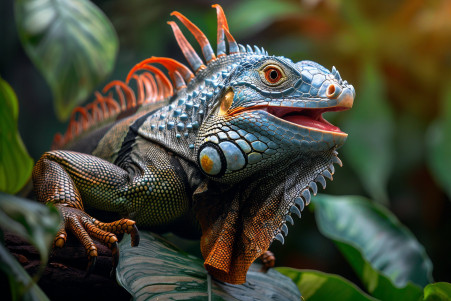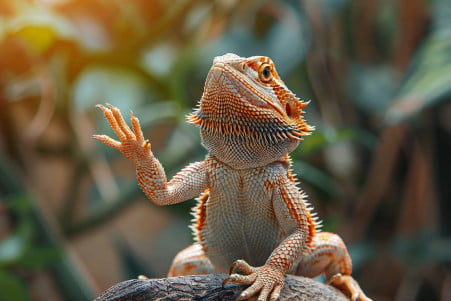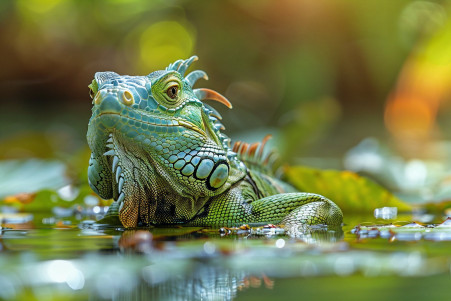Why Do Lizards Head Bob? Unveiling Its Meaning
20 April 2024 • Updated 19 April 2024

Is head bobbing in lizards just a territorial display, or is there more to this behavior that can be traced back to the evolution of communication and social behavior? Head bobbing is a type of non-verbal communication in lizards. It is used to establish territory, attract mates, recognize conspecifics, and even communicate more complex social signals like aggression, submission, and receptivity to mating.
This has led to the interest of behavioral ecologists and evolutionary biologists. In this article, we will explore the research in these areas that has provided insight into the potential origins and functions of this interesting behavior. By looking at lizard social systems, signaling systems, and principles of evolutionary adaptation, we can come to a better understanding of this common yet mysterious behavior in lizards.
Why do lizards bob their heads?
What Head Bobbing Means in Lizards
Head bobbing is a highly nuanced form of communication that lizards use to express a wide range of messages and emotions. The rate, duration, and rhythm of head bobs can all be used to communicate different feelings and intentions, including aggression, submission, courtship, and territoriality. For example, reptile.guide explains that male bearded dragons head bob rapidly and forcefully to show dominance over other males and to attract females during the breeding season. Meanwhile, female bearded dragons are more likely to head bob in a slower, less aggressive manner to show dominance or submission.
Males often head bob rapidly and forcefully to show dominance over other males and to attract females during the breeding season. As The Bug Shed points out, this can be a sign of the lizard's emotional state and motivation. Females may head bob in a slower, less aggressive manner to show that they are willing to mate with a male who is showing interest. However, the way that lizards head bob can also be influenced by the species and their social structure. According to the Herpetoculture Network, in some species, such as anoles, head bobbing can be a simple, compound, or highly complex visual display that is accompanied by color changes and dewlap extensions. This highly detailed form of lizard head bobbing enables them to communicate a wide range of social messages.
Head Bobbing and Lizard Social Dynamics
Head bobbing is an important part of how lizards establish and maintain social hierarchies and dominance. As noted in Topics in Neuroethology: Aggression in Lizards, male anole lizards use assertion displays and challenge displays, which often include head bobbing, to show their dominance and stake their claim to territory. The intensity and frequency of head bobbing can be used to determine a lizard's social status and rank within a social group.
Dominant males are more likely to engage in aggressive head bobbing and do so more often, while those with lower social status may engage in a more submissive type of head bobbing to avoid conflict. For example, as noted in the Green Iguana Head Bobbing resource, male iguanas with lower social status may try to avoid conflict with dominant males by using a head bobbing pattern that makes them look more like females. In addition, the ability to use head bobbing to establish social status can be affected by other factors, such as physical characteristics like head size and coloration, as demonstrated by the ScienceDirect study on green anole lizards.
Head Bobbing in Lizard Reproduction
Head bobbing is an important part of lizard reproduction, especially for male lizards trying to attract female lizards. For example, in a study of Ameiva ameiva lizards, males first approach females in short bursts followed by head-bobbing displays. These displays then continue as the male circles and shifts positions on the female.
Males perform complex head bobbing displays, often in combination with other behaviors like dewlap extensions or push-ups, to show their vigor and interest to potential mates. In the case of Anolis carolinensis lizards, a study found that both males and females perform the same three headbob patterns, but the frequency of each pattern depends on the social situation. Meanwhile, females are selective in their responses to male head bobbing displays, preferring patterns, frequencies, or intensities that indicate a male is a good potential mate.
The success of a male's head bobbing display can impact whether or not he is able to successfully court and mate with a female. In fact, a study of brown anole lizards found that females may even perform head bobbing displays during courtship, either to show that they are receptive to a male's advances or to show dominance over potential mates. These results show that head bobbing is a multifaceted part of lizard reproduction.
Comparative Analysis: Head Bobbing Across Lizard Species
The head bobbing behavior and the purposes it serves can be quite different between lizard species, and these differences can be explained by the species' evolutionary lineages and ecological niches. For example, in a study of Galápagos lava lizards, some species have more complex and elaborate head bobbing displays, while others have simpler displays. The researchers determined that simpler displays were more likely to be correctly identified by species than more complex displays.
The circumstances and meaning of head bobbing can also vary between species, with some species using it primarily for territorial defense and others for courtship. For example, as Phys.org reported, male Anolis lizards in Jamaica and male Draco lizards in Malaysia have evolved similar head bobbing displays to overcome the challenges of communicating in visually 'noisy' environments, even though they are not closely related species. The differences in head bobbing displays may be due to genetic drift, species recognition, or environmental factors.
Comparative analyses of head bobbing across lizard taxa can help researchers understand the evolutionary origins and adaptive significance of this behavior.
Evolutionary Roots of Head Bobbing in Lizards
It is thought that head bobbing in lizards has evolved as an adaptive form of communication that is the result of natural selection. A PDF study on the green anole lizard found that the basic components of adult head bobbing displays are in place early in an individual's development, which suggests that maturation, rather than social learning, is the main factor in the development of these stereotyped communication signals. The ability to communicate detailed information through visual displays like head bobbing may have given lizards an edge in their environments.
Head bobbing may have evolved as a way to establish dominance hierarchies and reduce the amount of physical conflict within social groups, which would lower the risk of injury. As reported by Phys.org, natural selection has led to the evolution of very similar head bobbing displays in unrelated lizard species that live in the same environments, which suggests that this form of communication has been evolutionarily advantageous. In some species, head bobbing may have evolved as a courtship display, which would allow males to show off their fitness and females to evaluate potential mates, as is discussed in a study on the Ameiva ameiva lizard.
The evolution of head bobbing displays may also be driven by other factors, such as predator avoidance, as is suggested by a study on brown anole lizards, or the need for effective communication in visually complex environments, as is discussed in the Phys.org article. By exploring the evolutionary roots and adaptive nature of head bobbing, we can learn more about the complex social and environmental influences that have led to the wide range of lizard behaviors.
Conclusion: The Fascinating World of Lizard Head Bobbing
Head bobbing is a complex and multifaceted behavior that plays a crucial role in the lives of many lizard species. This intriguing reptilian gesture serves various functions, including territorial defense, social dominance, courtship signaling, and species recognition. The evolution of head bobbing displays reflects the adaptive pressures and communication needs faced by lizards in their respective environments.
Studying head bobbing behavior provides valuable insights into the social dynamics, mating systems, and evolutionary histories of different lizard taxa. As research continues to unravel the nuances of this captivating phenomenon, our appreciation for the intricate world of lizard communication deepens.


